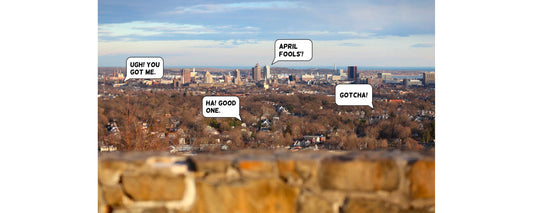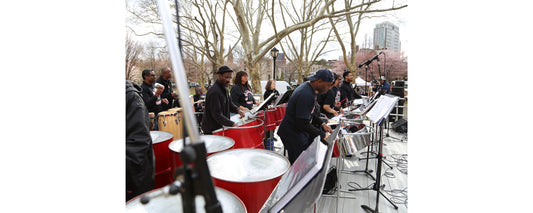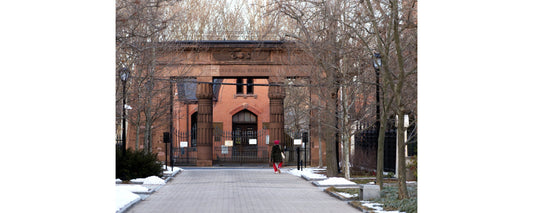To mark the 75th anniversary of D-Day this week, Daily Nutmeg is publishing a four-part series examining New Haven’s impact on World War II—and vice versa.
* * *
The distinctive, reedy pulse of bandleader Glenn Miller’s “In the Mood,” “Moonlight Serenade” and other record-breaking hits jazzed listeners nearly 80 years ago. But New Haveners of the World War II era didn’t have to buy a record or tune their radio dials to hear Miller. They just had to stand along Chapel Street or visit the Green on any given evening.
Miller was based in New Haven from 1943 to 1944 after being inducted into the U.S. Army. Convincing officials he could modernize the military’s musical efforts, improve the morale of troops and raise money for the war effort, he was given the task of organizing the Army Air Forces Band. By that time, the Glenn Miller Orchestra had already released dozens of top ten hits, including—in addition to “In the Mood” and “Moonlight Serenade”—“Tuxedo Junction,” “Chattanooga Choo Choo,” “When You Wish Upon a Star” and “Don’t Sit Under the Apple Tree (With Anyone Else But Me).”
sponsored by
“A fair number of local residents who are ‘of a certain age’ remember listening to the band’s rehearsals while they stood on the sidewalks outside its rehearsal hall as well as watching the band march to the New Haven Green,” says a recollection of Miller on the website of Grove Street Cemetery, where a black granite marker commemorates his time in New Haven. The band marched from Yale Bowl to the Green for a flag ceremony every evening, says Judith Schiff, chief research archivist at Yale. “It was like a parade every day.” According to music writer and Hamden resident Franz Douskey, the band played Miller’s arrangement of the W.C. Handy tune “St. Louis Blues March,” and a solo bugler played the traditional “Taps” as the flag was lowered.
At the time, Schiff says, Yale was serving as a military base, with only two residential colleges open for students: men who were training to become officers or who were not suitable for the draft. Captain Miller took up residence in the Taft Hotel and led countless rehearsals in New Haven for his wartime radio show I Sustain the Wings, episodes of which were broadcast live from Yale’s Woolsey Hall. (The program’s title was a translation of the Latin motto of the Army Air Forces, “Sustineo Alas.”) Other episodes were broadcast from around the country as well as Great Britain. Miller and the band also performed in numerous New Haven venues, including the New Haven Airport, the Shubert, Yale Bowl and New Haven Arena, according to Grove Street.
On December 15, 1944, Miller boarded a military transport plane from London to Paris. According to his biography on the Glenn Miller Orchestra website, he was traveling ahead of the band to make arrangements for a planned six-week tour of Europe. The plane disappeared, and Miller’s body was never recovered.
The polished black stone at Grove Street bears an image of Miller in uniform along with pertinent facts of his military service, birth, disappearance and local activities. The stone was erected in 1998 by local resident Peter Cofrancesco, who told the New York Times he dug into his own pocket to purchase the plot and the stone because New Haven “‘had the No. 1 band leader, the biggest band leader of all time… in our backyard in New Haven during the war. Nobody knew about that.’”
About 100 people attended a memorial service at Grove Street when the stone was installed, complete with music from the Paul King Orchestra, the Times reported. Schiff was one of them. She recalls the “amazing event” and the moment Bill Cameron, superintendent of the cemetery, “swooped up” Marie Callahan Castellon, who had served as Miller’s secretary during his time in New Haven, and danced the foxtrot.
Miller’s music remains remarkably popular. The Glenn Miller Orchestra regrouped in 1956 under the direction of Miller’s bandmate, drummer Ray McKinley, and still performs today. Yale musicians revived Miller’s music as well in a string of concerts that “re-enacted” Miller’s Woolsey Hall broadcasts, with the “stage dressed as it was in 1943 and members of the Yale Jazz Ensemble appearing in the roles of their counterparts from six decades ago, … complete with radio skits, vocalists, and a swinging big band,” according to a 2010 Yale School of Music announcement. Tom Duffy, director of university bands, played the role of Miller. “There wasn’t a dry eye in the house,” Schiff recalls.
Written by Kathy Leonard Czepiel. Image 1 features Glenn Miller, as published in Billboard circa 1942. Images 2 and 3, retrieved from Yale University’s Manuscripts & Archives collections, feature the “418th Army Air Forces Technical Command Band under the direction of Army Captain Glenn Miller” in Yale’s Woolsey Hall, 1943-44.








